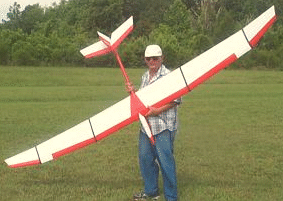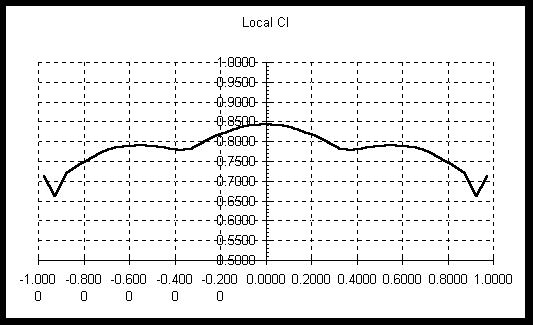

This model is designed to give me the best chance of getting the best possible score when flying 10-minute duration considering my skills and handicaps. Aerodynamic performance will be compromised as necessary to give the stability and control necessary to achieve these goals. Performance is of little value if I can't see the model well enough to control it when in a distant thermal. For the record, I am 68 years old with the attendant degradation of my vision and I have been designing and flying sailplanes since 1964.
| Format: | Three piece wing with maximum panel length of 48 inches. |
| Span: | 132 inches |
| Wing Area: | 1250 square inches |
| Aspect Ratio: | 14.1 |
| Wing loading: | 8.5 oz/sq. ft. |
| Planform: | Conventional with straight chord line. The dimensions of the individual panels are: |
| Root: | Chord 11 inches |
| Panel 1: | Span 24 inches, Outer Chord 11 inches, Dihedral 0 |
| Panel 2: | Span 30 inches, Outer Chord 8 inches, Dihedral 5 deg |
| Panel 3: | Span 10 inches, Outer Chord 6 inches, Dihedral 12 degrees |
| Tip: | Raked, with a span of 2.5 inches. The tip is not shown on the plan. The actual tip is rounded off to about a 1inch radius arc. This is achieved by starting with a wing tip with a ½ inch span at the leading edge and a 2.5 inch span at the trailing edge. The leading edge plan is then rounded off to approximate a 1inch radius. The wing thickness also tapers to a very sharp edge at the tip. This is a variation of the full sharp tip from Horner's Fluid Dynamic Drag book. |
| Washout: | I haven't found washout to be necessary to give acceptable stall characteristics for the combinations of airfoil and polyhedral that I have used to date. |
| Airfoil: | SD7032 at the root, transitioning to an SD7037 at the first dihedral break (24 inches out). |
| Fuselage | Length 50 inches without rudder. |
| Tail moment: | 25% of wingspan |
| Tail: | Cruciform for ease of setup and good controllability. |
| Stab area: | 15% of wing area for good pitch damping. |
The design calls for a wingspan of 132 inches with an SD7032 at the root quickly blending into an SD7037. The tips are Horner tips. We really cannot represent these in Liftroll but we do our best.
The zero-lift angles for the two airfoil sections are given in the Summary of Low-Speed Airfoil Data volume 3. The zero lift angle for a clean SD7037 is given as -3.4 and for a (turbulated) SD7032 as -4.2. In Liftroll terms, the difference represents a twist of +0.8 or wash out. Here's the logic:
If LR requires that an AOA of 10 degress is 10 degrees above the zero lift angle then here are the corresponding geometric AOAs:
Root SD7032 -4.2 + 10 = 5.8
"Tip" SD7037 -3.4 + 10 = 6.6
So the SD7037 has to be set at an angle 6.6 - 5.8 = 0.8 to the SD7032 if the whole wing is to go through zero lift at one angle. Assuming that Chuck has built it flat, which is his stated intention, then it will not have that positive .8 degrees. So the wing is effectively washed out by .8 degrees.
We shall not know the actual behavior of Lilan until sometime in the 2001 season but the predicted CL distribution shows that it should handle like a pussy cat but may get sinky at low speed if the center section stalls while the tips remain effective. Compare with John Hazel's Duckzilla.



